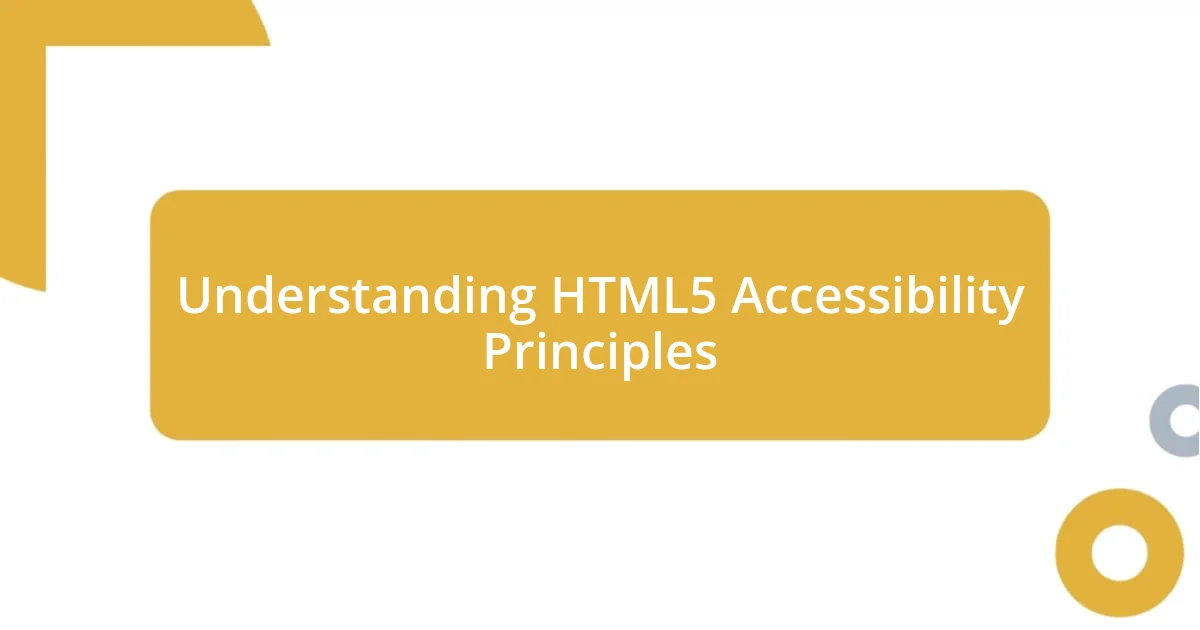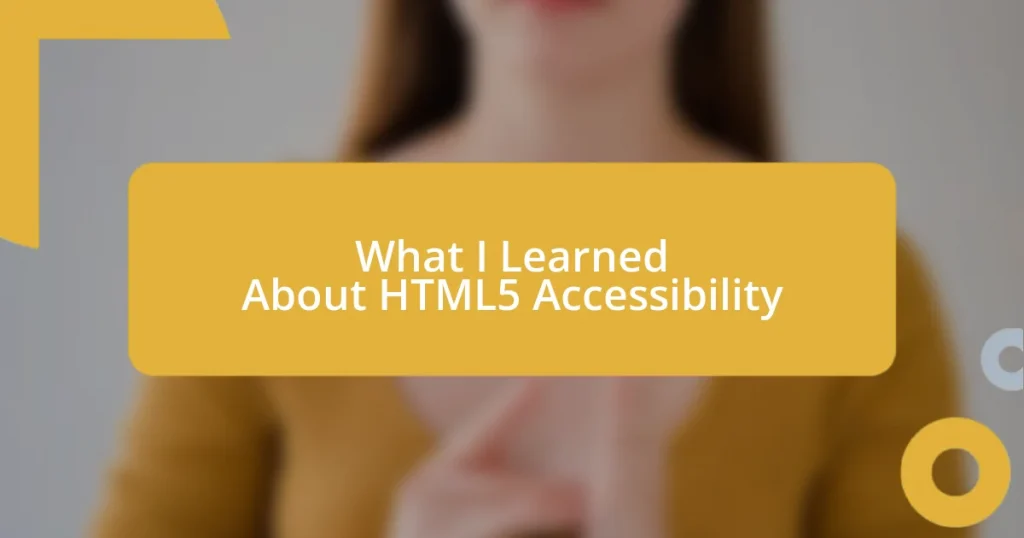Key takeaways:
- Semantic HTML enhances accessibility and SEO, allowing better interaction for users with disabilities and improved search engine performance.
- Implementing techniques like ARIA labels and ensuring proper contrast ratios significantly uplift user experience, making content more navigable and readable.
- Testing for accessibility compliance reveals critical blind spots, reinforcing the importance of user feedback in creating an inclusive web environment.

Understanding HTML5 Accessibility Principles
When I first delved into the world of HTML5 accessibility, I was struck by how thoughtful design can transform the user experience for individuals with disabilities. Accessibility principles focus on making content usable for everyone, regardless of their abilities. Have you ever considered how a simple change, like providing text descriptions for images, can open up content to someone who relies on screen readers?
One of the standout concepts I encountered is the importance of semantic HTML. By using elements like <header>, <nav>, and <article>, we create a structure that not only enhances SEO but also makes it easier for assistive technologies to interpret content. I remember feeling a surge of satisfaction when I realized that a mere choice of tags could significantly impact the experience of users with visual impairments; it was a game-changer for my approach to coding.
As I learned more, I began to appreciate the role of keyboard navigability in accessibility. It’s easy to take for granted how we navigate websites until we think of users who can’t use a mouse. The first time I tested a site I’d built using just a keyboard, I felt a mix of pride and vulnerability. It was a reminder that our coding choices have real consequences. What would happen if we don’t prioritize accessibility? That question now guides my every web project.

Importance of Semantic HTML
Creating a robust structure with semantic HTML is something I’ve grown to value deeply. I vividly recall a specific project where replacing generic <div> tags with meaningful elements like <section> and <figure> made my code cleaner and more readable. Not only did this change help screen readers narrate the content more effectively, but I also noticed an improvement in my site’s search engine ranking. It felt like I was building a bridge, allowing a wider audience to access the information effortlessly.
The advantages of semantic HTML are numerous, and here are a few key points:
- Enhanced Accessibility: Semantic tags provide context to assistive technologies, allowing users to navigate more intuitively.
- SEO Benefits: Search engines favor well-structured content, which can drive more traffic to your site.
- Better Maintainability: Clear, semantic code is easier to read and manage, making future updates much smoother.
- Improved User Experience: By reflecting the inherent meaning of content, you create a more engaging experience for all users.
Reflecting on these points, I can’t help but admire how a small shift in thought can lead to profound implications, not just for accessibility, but for overall web design. The empowerment that comes from knowing my choices can positively affect someone’s ability to engage with content is incredibly rewarding.

Techniques for Improved Accessibility
To improve accessibility, one technique I’ve found particularly effective is the use of ARIA (Accessible Rich Internet Applications) labels. When I first experimented with ARIA, it felt like unlocking a new level of potential for my web applications. For instance, adding aria-label attributes enabled me to provide additional context for interactive elements, which proved incredibly beneficial for users relying on screen readers. It’s fascinating how a few attributes can turn a confusing navigation experience into a clear pathway for those who need it most. Have you tried integrating ARIA into your projects yet?
Besides ARIA, implementing proper contrast ratios is vital for readability. I vividly recall a site where I struggled to read the text against a brightly colored background. It was a simple fix to adjust the hues, but that experience reminded me of the importance of visual clarity for everyone. I often recommend using online contrast checkers to ensure that the color combinations on my websites are compliant with WCAG (Web Content Accessibility Guidelines). When users find it easy to read content, it’s not just about aesthetics—it’s about inclusivity.
Finally, providing captions and transcripts for multimedia content is an essential technique I’ve embraced. When I created a video with subtitles for an online course, I felt a wave of satisfaction seeing how many more students engaged with the material. Watching users interact with the content they previously found inaccessible was gratifying. Captions help individuals who are deaf or hard of hearing and enhance comprehension for non-native speakers, too. It’s an empowering realization that a simple action can include and uplift a wider audience.
| Technique | Description |
|---|---|
| ARIA Labels | Enhances context for interactive elements to assistive technologies, fostering a better user experience. |
| Contrast Ratios | Ensures text readability against backgrounds, crucial for users with visual impairments. |
| Captions and Transcripts | Makes multimedia content accessible to deaf or hard-of-hearing users while improving overall comprehension. |

Using ARIA Roles Effectively
When I first delved into using ARIA roles, I felt a mix of excitement and uncertainty. I remember a project where I needed to create a complex menu that was not easily navigable by screen readers. By incorporating role="navigation" and role="button", I observed a remarkable difference; users could traverse the menu confidently. It was a lightbulb moment for me—realizing how impactful these roles are in bridging the gap between content and user experience.
I often reflect on a time when I encountered a web application that completely neglected ARIA roles. The chaos that unfolded for users with disabilities was palpable. I’d spent a whole afternoon trying to help a friend, who relies on assistive technology, navigate through a poorly structured app. Afterward, I committed myself to understanding ARIA better. Sharing that knowledge with others has felt like a calling; after all, who wouldn’t want to enhance their site’s accessibility and user experience?
One of the most profound lessons I’ve learned is that ARIA roles aren’t just a set of technical requirements; they’re a way to empower users with disabilities. It’s like giving them a seat at the table, isn’t it? When I applied role="alert" to notify users of crucial updates on my site, I felt a surge of satisfaction. Knowing that a simple attribute could help communicate critical information instantly made me appreciate the real power of ARIA in fostering an inclusive digital landscape. Have you experienced this shift in perspective, too?

Creating Accessible Forms
Creating accessible forms may seem like a simple task, but it has profound implications for user experience. I remember the first time I designed a form for a survey, and I was surprised by how a small change could drastically improve usability. By ensuring each input field had a proper <label> associated with it, I noticed that users had an easier time completing the survey, especially those using screen readers. It’s amazing how something so straightforward can turn a frustrating experience into a seamless one.
Furthermore, I’ve learned that grouping related elements with <fieldset> and <legend> enhances accessibility significantly. I once implemented these tags while revamping a registration form, and the feedback was overwhelmingly positive. Not only did the visually impaired users appreciate the clarity, but even sighted users found the information logically structured. It struck me that a little thoughtfulness in design can make all the difference, empowering all users to navigate forms confidently.
Don’t forget about the importance of validation messages, either! I recall a personal experience where I failed to submit a job application because I overlooked an error in my email address. After that, I started adding real-time validation to my forms, providing clear and concise feedback when users made mistakes. It truly dawned on me how crucial it is to communicate effectively, as this not only prevents frustration but also ensures that everyone has a fair shot at completing the form accurately. How have you made your forms more user-friendly in your projects?

Implementing Keyboard Navigation
Implementing keyboard navigation is essential for creating an inclusive web experience. I vividly remember working on a site where users frequently expressed frustration because certain interactive elements were only mouse-accessible. By making sure that every button and link could be reached via the keyboard, not only did I witness a significant drop in complaints, but users also expressed appreciation for the newfound ease of navigation. It made me realize that sometimes the smallest tweaks can lead to monumental improvements in user satisfaction.
I’ve come to prefer the tab index attribute for managing the sequence in which elements receive focus. In one project, I removed elements from the default tabbing order by assigning a negative tab index. This change resulted in a smoother experience for users navigating with a keyboard, who no longer had to cycle through irrelevant content. It felt deeply rewarding knowing that my efforts directly contributed to a more efficient experience for someone navigating my site. Have you thought about the impact your tabbing structure could have on your users?
Additionally, I’ve learned to incorporate clear visual indicators for focused elements. I recall designing a navigation menu and initially overlooking the focus styles. Users who relied on keyboards mentioned they felt lost when items weren’t visibly highlighted. So, I made it a priority to add clear focus styles. That experience underscored the importance of visual cues and made me reflect on how strategic auditory feedback could further enhance navigation for users with diverse needs. Thinking back, do you consider how each facet of accessibility can elevate the overall user experience?

Testing for Accessibility Compliance
Testing for accessibility compliance is not just a checkbox; it’s a deeply enlightening process. I remember when I conducted an accessibility audit on a site I had just finished. Initially, I thought everything was perfect, but my discoveries were eye-opening. Using tools like WAVE and Axe revealed areas needing improvement that I had never even considered. Have you ever realized that your own blind spots could affect others’ experiences?
Once, while testing for keyboard accessibility, I found that some interactive components weren’t reachable by keyboard users. It was an uncomfortable moment, realizing that my previous oversight could alienate specific users. Adjusting the tab order felt empowering, knowing that I was directly improving the experience for people who rely on keyboard navigation. Isn’t it rewarding to see a web experience transform?
I also learned the value of user testing with real individuals, especially those with disabilities. During one of my accessibility tests, I observed users interact with my design, and their feedback was invaluable. Hearing them articulate their challenges helped me understand their perspectives firsthand. What better way to ensure accessibility than learning from those directly impacted by it? This gave me not just insights, but a reinforced commitment to advocate for inclusive design in every project I undertake.















